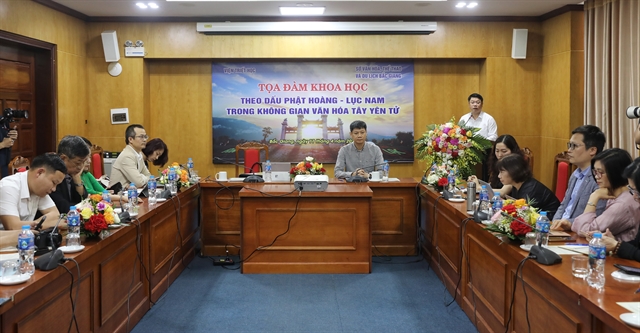 Life & Style
Life & Style


|
| Delegates take part in a recent scientific seminar entitled "Following the footsteps of Emperor-Monk -- Lục Nam in cultural space of Tây Yên Tử". |
BẮC GIANG – The important role of Bắc Giang Province’s Lục Nam District in the flow of national history and the relationship between the Trúc Lâm Yên Tử Zen Buddhist sect and Emperor-Monk Trần Nhân Tông has been discussed and confirmed among national scientists and experts.
The Institute of Philosophy (Việt Nam Academy of Social Sciences) in collaboration with the provincial Department of Culture, Sports and Tourism recently organised a scientific seminar entitled "Following the footsteps of Emperor-Monk -- Lục Nam in the cultural space of Tây Yên Tử".
The ancient land of Lục Nam is located in the eastern region of the province, which saw the prosperity and development of the Trúc Lâm Yên Tử Zen Buddhist sect, an important step on the path of propagating Buddhism by the Trúc Lâm patriarchs.
This is a spiritual land, with majestic mountains, beautiful natural landscapes, and the Lục Nam River with glorious victories. It is also home to many cultural and religious works associated with the history of building and defending the country.
According to Associate Professor Doctor Nguyễn Tài Đông, director of the Institute of Philosophy, Lục Nam, an ancient land of present-day Bắc Giang Province (formerly Kinh Bắc land), is a geo-ecological area.
This land is located in the northwest of the Tây Yên Tử range, with a series of Buddhist relics from the Trẩn and early Lê dynasties, such as Am Vãi, Bát Nha and Khám Lạng pagodas.
Assoc. Prof. Dr. Đông said that through the seminar, delegates would supplement information and documents, clarifying the values of Lục Nam. And they would also contribute to finding out research directions, implementation plans, and multi-dimensional perspectives on its geography, history, and culture and build a database about the land (including Han Nom documents, ancient maps, archaeological documents, and field investigation documents on customs and religious practices).
Dr. Trần Anh Dũng from the Việt Nam Archaeological Association said there were 187 Buddhist relics in the Tây Yên Tử range, 74 of which were in Lục Nam.
He said it was necessary to systematize the documentation of the Trúc Lâm Tây Yên Tử Pagoda system in Bắc Giang to evaluate its historical and cultural values while also research the similarities and differences of the Trúc Lâm system in Tây Yên Tử and Tây Thiên in Vĩnh Phúc Province, and those in Tuyên Quang and Yên Bái provinces. From there, local authority could promote the values of the Tây Yên Tử in cultural, social, economic and tourism development.
Dr. Nguyễn Anh Thư from the Hà Nội University of Culture’s Department of Cultural Heritage said that the Yên Tử mountain range was one of the most important political, socio-economic, and spiritual cultural centres of the country of Đại Việt, the second-longest used name for Việt Nam in the past.
During the Trần Dynasty, Vĩnh Nghiêm Pagoda (Bắc Giang) was the abbot of all three monks, Trúc Lâm Tam Tổ, who founded the Trúc Lâm Zen. It was the headquarters of the Trúc Lâm Buddhist Sangha, and also the first monk and nun training monastery in Việt Nam. From this centre, Trúc Lâm Buddhism was propagated in the Tây Yên Tử Mountain.
Dr. Thư affirmed that it was necessary to promote the implementation of archaeological planning in the Tây Yên Tử region in general, and map the distribution of archaeological relics of the Lý - Trần dynasties in Bắc Giang in particular to preserve and promote the relics’ value.
In addition, a comprehensive research programme on pagoda and tower relics in the Tây Yên Tử cultural space in Bắc Giang was needed to clarify the position and role of this land in the history of the development of Trúc Lâm Buddhism.
Speaking at the end of the seminar, Deputy Director of the Bắc Giang Department of Culture, Sports and Tourism Đỗ Tuấn Khoa affirmed that the opinions of researchers, experts, and managers were valuable contributions, helping clarify historical issues, positions, and roles of Lục Nam District in particular, and the Tây Yên Tử area in general regarding Buddhism propagation by Emperor-Monk Trần Nhân Tông.
The seminar affirmed the value of Lục Nam in the cultural space of Tây Yên Tử - Bắc Giang. It also honoured the heritage of Trúc Lâm Yên Tử Buddhism and relics and scenic spots of the Tây Yên Tử area.
The seminar contributed to preserving the nation's cultural heritage, promoting investment efficiency, exploiting the potential and advantages of heritage for local socio-economic development.
At the same time, it opens up opportunities to attract tourism investment, especially spiritual - ecological tourism, creating motivation for Bắc Giang tourism in general and Lục Nam district tourism in particular to develop in the future. VNS